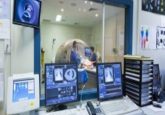Fluorescent nanoprobes may be the future of noninvasive cancer detection

Researchers from the Agency for Science, Technology and Research (A*STAR; Singapore) have developed a hybrid metal–polymer nanoparticle that fluoresces in the acidic environment surrounding tumor cells. The study was published in the journal Small.
Tumors typically have lower than normal pH levels due to increased acidity both in the intracellular environment and within the extracellular microenvironment. This difference between tumor cells and normal cells has led several research teams to create probes that can detect the low pH of tumors utilizing optical imaging, magnetic resonance and positron emission tomography.
Most of these probes, however, target the intracellular pH, which requires the probes to enter the cells in order to function. Success lies in the development of probes that would not need to enter the cells, however detecting minor differences in extracellular pH between healthy tissue and tumor tissue has so far been difficult. In collaboration with colleagues from the National University of Singapore, the A*STAR team based their new probe on polymers that self-assemble on gold nanoparticles. While the probe is not fluorescent at normal physiological pH, this new hybrid structure reacts to acidic conditions of approximately pH 6.5, similar to those surrounding tumor cells. Exposure to an environment of this pH alters chemical groups on the surface of the probes, which in turn causes them to fluoresce.
After validation in pH-controlled solutions, the probes were tested in vitro with cultured cells and in vivo using tumor-bearing mice. Twenty-four hours postinjection whole-body imaging and examination of removed organs from the mice revealed clear fluorescence only in tumor-bearing tissue. The ability to observe the fluorescence of tumors using noninvasive whole-body imaging techniques in living mice indicates the potential of the nanoprobes for use in clinical situations with human patients.
Nonspecific probes that are able to identify any kind of tumor are extremely useful for monitoring the location and spread of cancer and the effects of treatment, as well as aiding initial diagnosis.
“Our probes have so far proved to be biocompatible, which will be crucial for biomedical applications,” commented author Bin Liu (A*STAR). “We now plan to check further for any toxicity issues and assess the biological distribution and pharmacological profile of the probes before hopefully moving on to clinical trials.”
Sources: Yuan Y, Ding D, Li K, Liu J, Liu B. Tumor-Responsive Fluorescent Light-up Probe Based on a Gold Nanoparticle/Conjugated Polyelectrolyte Hybrid. Small, 10 (10): 1967–1975 (2014); A* Star research press release





